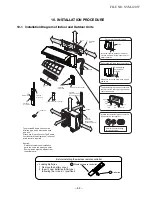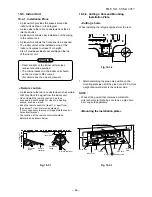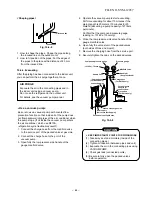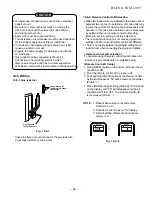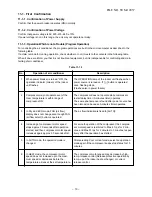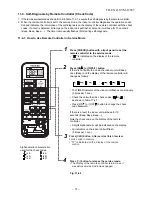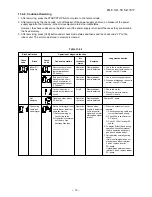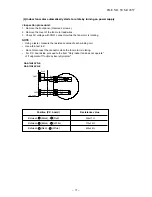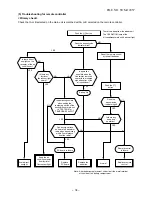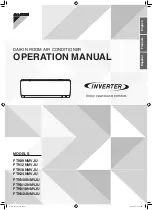
–
63
–
10-4-3. Refrigerant Piping Connection
<Flaring>
1. Cut the pipe with a pipe cutter.
Fig. 10-4-4
2. Insert a flare nut into the pipe, and flare the pipe.
• Projection margin in flaring : A (Unit : mm)
Rigid (Clutch type)
Imperial (Wing nut type)
90˚
Obliquity
Roughness
Warp
Die
Pipe
A
Outer dia. of
copper pipe
∅
6.35
∅
9.52
∅
12.7
R410A
tool used
0 to 0.5
0 to 0.5
0 to 0.5
Conventional
tool used
1.0 to 1.5
1.0 to 1.5
1.0 to 1.5
Outer dia. of
copper pipe
∅
6.35
∅
9.52
∅
12.7
R410A
1.5 to 2.0
1.5 to 2.0
2.0 to 2.5
Fig. 10-4-5
<Tightening Connection>
Align the centers of the connecting pipes and tighten
the flare nut as much as possible with your fingers.
Then tighten the nut with a wrench and torque
wrench as shown in the figure.
Fig. 10-4-6
Half union
Flare nut
Externally
threaded side
Internally
threaded side
Use a wrench
to secure.
Use a torque wrench
to tighten.
Outer dia. of copper pipe
Ø6.35 mm
Ø9.52 mm
Ø12.7 mm
Tightening torque
16 to 18 (1.6 to 1.8 kgf•m)
30 to 42 (3.0 to 4.2 kgf•m)
50 to 62 (5.0 to 6.2 kgf•m)
Flare at
indoor unit
side
Flare at
outdoor unit
side
CAUTION
• Do not apply excessive force.
Otherwise, the nut may break.
(Unit : N·m)
• Tightening torque of connection of flare pipe connections
The operating pressure of R410A is higher than that
of R22 (Approx. 1.6 times.) It is therefore necessary
to firmly tighten the flare pipe connecting
sections (which connect
the indoor and outdoor units)
up to the specifed tightening
torque. Incorrect
connections may
cause not only a
gas leakage, but also damage to
the refrigeration cycle.
Fig. 10-4-7
FILE NO. SVM-12057




